
Fractures Page Menu: 1 2 3 4 5 6 7 8 9 10 11 12 Next>>
Fracture Treatment During the Golden Age of Piracy, Page 4
Restoring the Bone
Moving from the theory of fractures into the practical realm, we come to the first step in reparing a fracture during the golden age of piracy. This is to restore the bone.
Successfully healing a fracture required replacing the bone to its original position so that nature could rebuild the break. Matthias Gottfried Purmann noted that fractures were common
occurrences, but "to Set and Restore them gracefully, we find by experience is not every Chirurgeons Talent."1 Hippocrates doesn't seem to regard the task as being that difficult. "When sufficiently extended [pulled
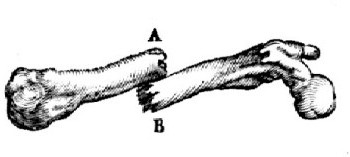
If Only It Were That Simple... Broken Thigh Bone From
Opera quae extant omnia, by William Fabry and Marcus Severinus (1682)
apart], it will be easy to adjust the bones and bring them into their natural position, by straightening and arranging them with the palms of the hand."2
Several factors were considered by period authors in this part of the operation, suggesting it may not have been quite as easy as Hippocrates presents it. Among the details of properly setting a fracture were removal of foreign bodies and slivers, preparing equipment for setting a fracture, extension of the bone by assistants and/or machines, setting the bone, checking the result, sawing broken bone ends, dealing with distortion in the bone, and setting non-limb fractures. For such an easy procedure, there were many things to consider!
1 Matthias Gottfried Purmann, Churgia Curiosa, p. 211; 2 Hippocrates, Hippocratic Writings, Translated and Edited by Francis Adams, p. 81
Restoring the Bone: Removing Slivers of Bone
Before the bone could be set, foreign bodies, particularly broken off slivers of bone had to be removed from the wound site. Otherwise the healing process would be retarded. Richard Wiseman explains that when slivers of bone were broken off, "Nerves, Tendons, &c. are grievously pricked and torn, and are subject to extraordinary Pain, Inflammation, Convulsions, and Death, unless
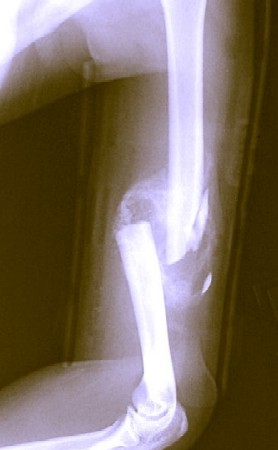
Photo: Bill Rhodes
An X-Ray of a Fracture With Slivers
immediate Remedy be had by removing those [slivers of] Bones"1. Sea surgeon John Atkins agrees. "Any separated Portion of Bone, that we think cannot be replaced and reunited, we must cut and take away"2.
When the fracture was compound, removal of bone fragments was more easily performed. Atkins explains that when a "Bone is so comminuted [broken into pieces], and [such] that several Particles and Shivers of it are to be brought away, a large Wound is safer and more commodious for this End, than a small"3. For large wounds, he suggests that bone fragments can be "easily removed with Forceps and Scissars"4. However, when the small size of a wound is "an Impediment to Extraction, as in Fractures from Musket-Shot, whose Orifices contract, there is an absolute Necessity of dilating."5 'Dilating' would be performed with a scalpel or pen knife.
With this apparently decided, Atkins beings to equivocate. He explains that he is for enlarging the wound when removal "will be of less noxious Portent, than permitting the Exaggeration of Symptoms that directly tend to the Destruction of the Patient."6 He reveals that he himself tends,
after a diligent Search and Extraction at first, to leave the Remains [of bones and matter in the wound] to the Expulsion of Nature, by an Apostemation [discharge of pus], assisting hereto, by anodyne Administrations [pain relieving medicines], mild Cataplasms of Farin. Avenac. [wheat oats] and a soft quiet Position; for there is no Fear that she [nature] will ever sit down easy with so inhospitable a Guest: Nature will, as she is wiser than we, effect the Exclusion of it in her own Time, by a gentler and easier Way, than making a blindfold Incision.7
He does warn that doing so may cause the slivers to "slide between the broken Ends of the Bone, and cause them to foul and exfoliate [cast off dead skin]; yet even this may in great Measure, be avoided, by making a Vent in some depending Part, and diverting the Discharge; so that on the Whole, I conclude, it is sometimes safer trusting to Nature than to ourselves."8
So Atkins is really only in favor of opening a wound further to remove slivers and other objects in the wound when not doing so endangers the life of the patient. As he explains, Nature "more kindly thrusts towards the Orifice any remaining Extraneosity, than can be effected by any dark Search with Probe or Forceps, especially in thick muscular Parts"9.
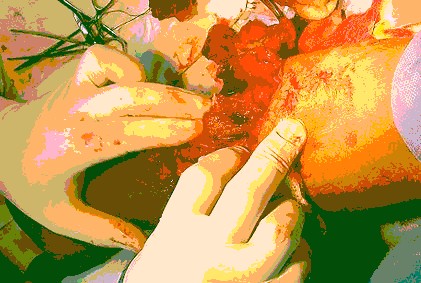
Photo: Bob J. Galindo
Examining the Wound in a Compound Fracture with Slivers
Sometimes the surgeon felt it was necessary to remove slivers of bone when the fracture was simple, which would require creating a new incision. Military surgeon William Clowes tells of a patient with a rib fracture whom he could not bring "any ease until I made incision directly upon the fracture, according to the length of the rib and so down unto the bone; and there I did take out that shiver [sliver] or spell of bone, which was in bigness, thickness and length the like unto a barley corn, sharp at both ends like unto the point of a needle"10.
When bone extraction was performed, most surgeons agreed that it should be done soon after the fracture occurred. Atkins advises that the procedure is "easiest to be done now when the Patient is warm with Action"11. Sea surgeon John Moyle suggests that "if there be any loose splinters, take them out, (if possible) it will be better done now whilst the Man is hot [from the wounding], then hereafter"12.
1 Richard Wiseman, Of Wounds, Severall Chirurgicall Treatises, p. 420; 2 John Atkins, The Navy Surgeon, p. 45; 3 Atkins, p. 64; 4 Atkins, p. 67; 5 Atkins, p. 64; 6,7,8 Atkins, p. 68; 9 Atkins, p. 64; 10 William Clowes, Selected Writings of William Clowes, p. 96; 11 Atkins, p. 65; 12 John Moyle, The Sea Chirurgeon, p. 116
Restoring the Bone: Preparing for Extension
Although there generally wasn't much equipment required to perform this operation, some of the period surgeons do give instructions for readying equipment. When discussing the treatment of a seaman with an 'extremely shattered' arm who would not allow him to cut it off,
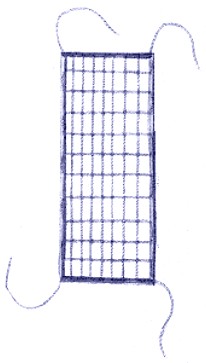
Artist: Album del Marques de la Victoria
A Mariner's Bed, (1756)
Thanks to Adam Cripps for Finding
This Image
military surgeon Richard Wiseman explained how he prepared to operate once the ship had 'gotten into the next Port'.
I caused this Mariners Bed to be set up: (which was four pieces of Wood nailed together and corded [he most likely means a rope work bottom made for the bed], and a Bears Skin laid upon it, and fastened between two Guns to the Carriages:) upon this I saw him placed; and having ordered his Arm to be laid so that I might the better come to dress it, I sent for dressings, and laid them orderly upon a small Pillow well stuft and quilted in the middle. Upon this Pillow I first laid a soft double linen Cloth, next to that three Ligatures [strands to be used as ties], then a Pastboard wet in Vinegar, to make it more soft and pliant; to encompass the fractured Member, which I cut from each end to the middle into three Binders [broad bandages - Wiseman appears to be referring to the ligatures]: Over this lay my Defensative (medicine to prevent bad humours from gathering at a wound) spread on a thick Cloth, of such a breadth and length as to take in the whole Arm.1
Comfort of the patient seems to be at the forefront of Wiseman's preparations. It is notable that no surgical tool is even mentioned here; surgical tools were not required for extending (pulling apart) the bones and setting them.
Ambroise Paré provides some suggestions about how to prepare for setting the bone as well. He suggests putting the patient "in some place which hath good and sufficient light. Then let trusty and skilfull attendants be there, good ligatures (cloth strips to be tied around the part) , and also, if need so require, good engines."2 'Engines' refer to mechanical devices used to extend the parts above and below the fracture. These will be discussed in greater detail later in this article.
1 Richard Wiseman, Of Wounds, Severall Chirurgicall Treatises, p. 426; 2 Ambroise Paré, The Apologie and Treatise of Ambroise Paré, p. 167
Restoring the Bone: Extension by Assistants
The primary work of the surgeon is setting the bone so that the two fractured halves meet as well as he can arrange them. While he is doing such delicate work, he needs to have each of the fractured pieces of bone pulled apart so he can properly adjust the bone so that it fits together. This can be done in two ways: by man or machine. Let's first look at the manual method.
Hippocrates says that "for the most part two strong men will suffice, by making extension [pulling on one side of the fracture] and counter-extension [pulling on the other]."1 John Atkins expands on the role of these assistants,
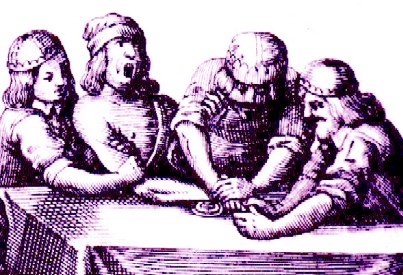
Artist: Jonas Arnold Delineavi
Assistants Helping the Surgeon to Set an Arm From Armamentarium
Chirurgicum Bipartitum by Johannes Scultetus, Table 48, p. 113 (1666)
"the one above, the other below the Fracture; the Business of the first is to hold the Limb steady, and at the same time to make such Contra-Extension, as may hinder its giving way to the greater Extension that must be made below"2.
Sea surgeon John Woodall explains this in detail, telling the surgeon to
make your extention (as is sayd) [so] that both ends of the bones meete together, namely, let one strong man take the one end of the fractured limbe, and another the other end, thy selfe standing free, and let them draw out the member, directly when thou art ready, & not before, neither by jumps, but leasurely and together, likewise if they beare their hands too high or too low in drawing, they cause great paine to the patient, and likewise cause the bone to lie unapt [indisposed] to thine hand to reduce it.3
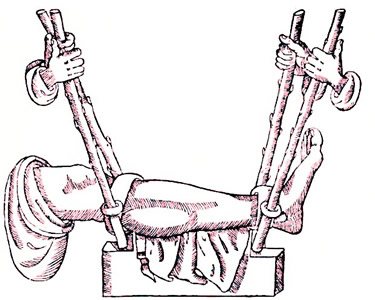
Leg Extension Suggested by Galen, From Vidi Vidii Opera Varia (1599)
Writing in the late 16th century, military surgeon William Clowes suggests an additional step, probably to make the process more comfortable for the patient and easier for the assistant to grip. "I made two decent towels and fastened each towel, one above the fracture and
the other below it. Then I caused two strong men to apprehend and take hold of each towel, and I placed myself very near to the fracture."4
Sea surgeon John Moyle also recommends using cloth ties, placing "a Ligature above the Fracture, and another beneath it; and let one Man take hold of the band above, and another of that beneath, and so make extention"5. This method is similar to that proposed by the ancient physician Galen, seen at left.
Matthias Gottfried Purmann suggests the work be done "with the help of four strong Men, two of which must take hold and stretch out the part above the Fracture, and the other two the part below the Fracture, with an equal Force on both sides, as far and strongly as is necessary; while the Chirurgeon in the mean while, puts the Bones in their right places."6 On the one hand, if the four men worked together carefully, the two extra men could make for a smoother pulling process, requiring a little less force (and thus jerkiness). The extra men would also allow for greater force to be applied when necessary. On the other hand, when extending an arm, four men would seem to get in each other's way. Perhaps this is why machines were used in extending larger bones.
1 Hippocrates, Hippocratic Writings, Translated and Edited by Francis Adams, p. 81; 2 John Atkins, The Navy Surgeon, p. 41; 3 John Woodall, the surgions mate, p. 164; 4 William Clowes, Selected Writings of William Clowes, p. 126-7; 5 John Moyle, The Sea Chirurgeon, p. 116; 6 Matthias Gottfried Purmann, Churgia Curiosa, p. 213
Restoring the Bone: Extension by Machine
Although he said that two men were usually adequate to extend the broken parts of the limb, Hippocrates also advised that "particular pains should be taken with regard to the extension that it may not be insufficient for when excessive, no great harm results from it."1 Ambroise Paré suggests that the surgeon must sometimes "use engines for this worke, especially if the luxation [dislocation] be inveterate [long-standing], if the broken or luxated bones be great; and that in strong and rustick bodies, and such as have large joints: for that then there is need of greater strength, than is in the hand of the Surgeon alone."2
The idea of using devices to extend a bone goes at least as far back as Hippocrates in the 4th century BC. The opinion of the 'ancients', such as Hippocrates,
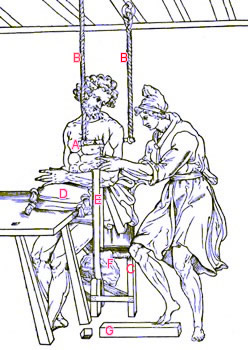
Arm Fracture Extension Machine Devised by
Hippocrates, From Vidi Vidii Opera Varia,
p. 257 (1599)
was highly regarded by classical surgeons during the golden age of piracy, which may explain some of the interest in the extension machines. Hippocrates mentions a few different mechanisms, giving a rather extensive description of one for extending a fractured arm.
The following, then, is the most natural plan of setting the arm: having got a piece of wood a cubit or somewhat less in length [A], like the handles of spades, suspend it by means of a chain fastened to its extremities at both ends [B]; and having seated the man on some high object [C], the arm is to be brought over, so that the armpit may rest on the piece of wood and the man can scarcely touch the seat, being almost suspended; then having brought another seat, and placed one or more feather pillows under the arm [D], so as to keep it a moderate height while it is bent at the right angle, the best plan it to put round the arm a broad and soft skin, or broad shawl [E], and to hang some great weight to it [F], so as to produce moderate extension; or otherwise, while the arm is in the position I have described, a strong man is to take hold of it at the elbow and pull it downward. But the physician standing erect, must perform the proper manipulation, having the one foot on some pretty high object [G], and adjusting the bone with the palms of his hands; and it will readily be adjusted, for the extension is good if properly applied.3

Leg Extension Machine With Pulleys Devised
by Paré, From The Workes of that Famous
Chirurgion Ambrose Parey, p. 371 (1649)
William Fabry finds "there are several Instruments, both by Hippocrates, Oribasius, and other Authors, set down; but I have always found in my practice the Instrument of Ambroise Parey, which is with a Pulley... it is not onely the most convenient, but most useful Instrument for all Fractures and Dislocations, except of the Fingers, Ribs, and Mandibles (which are set by the hand alone;) it is also little, and therefore not troublesome to carry about one."4
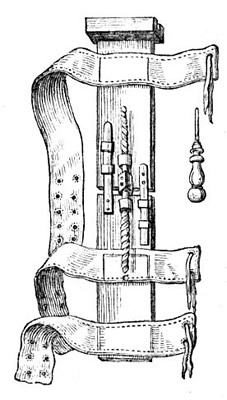
Fabry's Ingenious Fracture Extension Machine,
From Opera quae extant omnia, p. 481 (1682)
Perhaps an even more ingenious device for extending fractures is shown in Fabry's book Opera quae extant omnia. This device uses a simple screw system and could be used on any limb, provided the straps could be tightened properly for various limb circumferences. The size and configuration of an extension machine would be important considerations if it were to be used shipboard.
Not all surgical authors were in favor of using machines to extend a fracture. Naval surgeon John Atkins felt extension of a fractured part "is best done with your Hands, both because as great an Extension may be made with them, as any Fracture can require, as also because the Violence of any other Instrument might help [bring] on those ill Accidents which it should be our Care to prevent."5
Although
Paré was not against the use of machines, he does say that in bone extension it was "dangerous to draw the nerves and tendons too violently; for hence would ensue an impostume, convulsion, gangrene and mortification."6 It would probably be easier to over-extend a part using a machine, since it is one step away from actually feeling what was going on.
1 Hippocrates, Hippocratic Writings, Translated and Edited by Francis Adams, p. 82; 2 Ambroise Paré, The Apologie and Treatise of Ambroise Paré, p. 168; 3 Hippocrates, p. 78; 4 Guliielm. Fabritius Hildanus aka William Fabry, His Experiments in Chyrurgerie, p. 27; 5 John Atkins, The Navy Surgeon, p. 41; 6 Paré, p. 166;
Restoring the Bone: Setting the Fracture
Once all the preparations were made and the assistants or machines were ready to extend the two halves of the fractured part, the surgeon could set the bone. In setting a fracture of the thigh, military surgeon William Clowes explains that once the fracture was extended, "I did elevate or lift up that part of the bone which was depressed, and again, I did also press down the other part of the fractured bone which was borne up, and being rightly reduced [put into correct alignment] and restored again, as near as I could to nature’s former union"1.
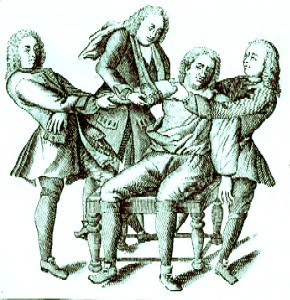
Fracture Extension and Setting, From A General System
of Surgery, by Lorenz Heister plate 10 (1770)
The actual restoring of the two halves of bone is regarded as a simple process by most period surgical writers. Ambroise Paré explains that once the fracture was extended, "the broken bones will sooner and more easily be restored to their former seate. Which being restored, you shall presently with your hand presse it downe, if there be any thing that bunches or stands out."2
While sea surgeon John Woodall does not go into great detail on how to set a fracture, he advises the surgeon to be "standing by with his hands upone the griefe, ...[so that] hee is able to set the ends of the bones in their place"3. John Moyle simply recommends that once the two halves are extended "you place the ends of the bones together"4.
Naval surgeon John Atkins provides a bit more description, telling the surgeon that he, "by feeling, shall find it made to a Degree fit for rejoining, you are by the Application of your Hands, to press and re-place the ends of the Bone smooth and even."5
Adjustment is sometimes required. Richard Wiseman warns that when a limb is fractured "Bones never lie exactly equal, and most frequently the ride one over another."6 He explains that so that "the Parts may be rightly joyned together, there is need of Extension, and Coaptation [adjustment of the two bones so they fit together properly]."7
Moyle adds a suggestion not mentioned by any of his compatriots. He suggest that "if the end of the [broken] bone will not easily go in again, make incision, and dilate [open] the Wound, but have a care of Vessels."8 Since he refers to 'dilating' a wound, he is clearly telling the surgeon to cut an
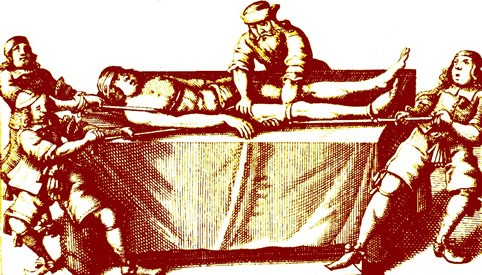
Surgeon Setting a Thigh Fracture, From Armamentum Chiurgicum by Johannes Scultetus,
Plate 49, p. 114 (1666)
existing wound - referring to a compound fracture. None of the period authors under consideration suggest cutting open a simple fracture so that it could be set.
After the fracture had been set, Clowes explains that he held "close together the parts which before [were] dissevered, and then caused the two men which extended the member, by little and little to release their hands"9. He explains that this easy release reduces the amount of pain the patient must endure. Richard Wiseman likewise advises that "the Extenders are to be loosened gently, and the Operatour must with his hand endeavour as gently to press down the ends of the Bones, and joyn them smooth and even together."10
1 William Clowes, Selected Writings of William Clowes, p. 127; 2 Ambroise Paré, The Apologie and Treatise of Ambroise Paré, p. 168; 3 John Woodall, the surgions mate, p. 160; 4 John Moyle, The Sea Chirurgeon, p. 116; 5 John Atkins, The Navy Surgeon, p. 41; 6,7 Richard Wiseman, Of Wounds, Severall Chirurgicall Treatises, p. 469; 8 Moyle, p. 116; 9 Clowes, p. 127; 10 Wiseman, p. 467

